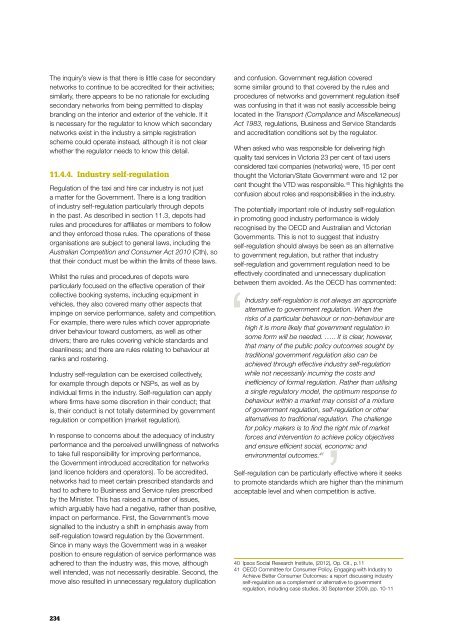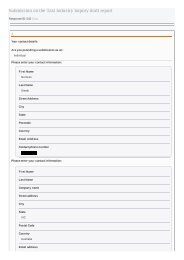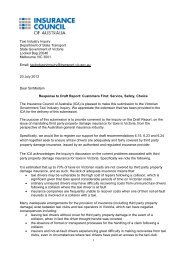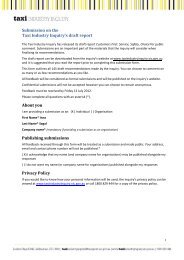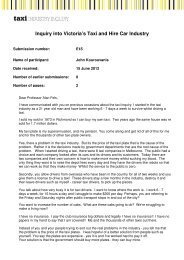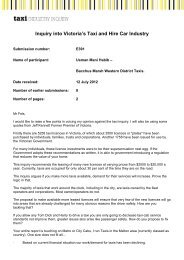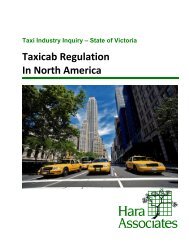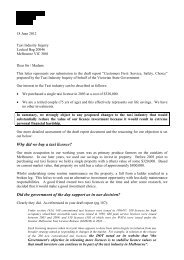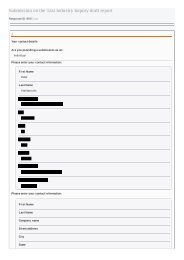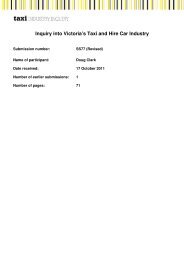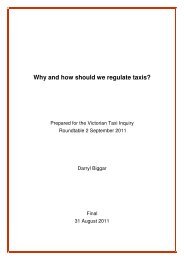Part D â Understanding and improving industry performance (PDF ...
Part D â Understanding and improving industry performance (PDF ...
Part D â Understanding and improving industry performance (PDF ...
Create successful ePaper yourself
Turn your PDF publications into a flip-book with our unique Google optimized e-Paper software.
The inquiry’s view is that there is little case for secondary<br />
networks to continue to be accredited for their activities;<br />
similarly, there appears to be no rationale for excluding<br />
secondary networks from being permitted to display<br />
br<strong>and</strong>ing on the interior <strong>and</strong> exterior of the vehicle. If it<br />
is necessary for the regulator to know which secondary<br />
networks exist in the <strong>industry</strong> a simple registration<br />
scheme could operate instead, although it is not clear<br />
whether the regulator needs to know this detail.<br />
11.4.4. Industry self-regulation<br />
Regulation of the taxi <strong>and</strong> hire car <strong>industry</strong> is not just<br />
a matter for the Government. There is a long tradition<br />
of <strong>industry</strong> self-regulation particularly through depots<br />
in the past. As described in section 11.3, depots had<br />
rules <strong>and</strong> procedures for affiliates or members to follow<br />
<strong>and</strong> they enforced those rules. The operations of these<br />
organisations are subject to general laws, including the<br />
Australian Competition <strong>and</strong> Consumer Act 2010 (Cth), so<br />
that their conduct must be within the limits of these laws.<br />
Whilst the rules <strong>and</strong> procedures of depots were<br />
particularly focused on the effective operation of their<br />
collective booking systems, including equipment in<br />
vehicles, they also covered many other aspects that<br />
impinge on service <strong>performance</strong>, safety <strong>and</strong> competition.<br />
For example, there were rules which cover appropriate<br />
driver behaviour toward customers, as well as other<br />
drivers; there are rules covering vehicle st<strong>and</strong>ards <strong>and</strong><br />
cleanliness; <strong>and</strong> there are rules relating to behaviour at<br />
ranks <strong>and</strong> rostering.<br />
Industry self-regulation can be exercised collectively,<br />
for example through depots or NSPs, as well as by<br />
individual firms in the <strong>industry</strong>. Self-regulation can apply<br />
where firms have some discretion in their conduct; that<br />
is, their conduct is not totally determined by government<br />
regulation or competition (market regulation).<br />
In response to concerns about the adequacy of <strong>industry</strong><br />
<strong>performance</strong> <strong>and</strong> the perceived unwillingness of networks<br />
to take full responsibility for <strong>improving</strong> <strong>performance</strong>,<br />
the Government introduced accreditation for networks<br />
(<strong>and</strong> licence holders <strong>and</strong> operators). To be accredited,<br />
networks had to meet certain prescribed st<strong>and</strong>ards <strong>and</strong><br />
had to adhere to Business <strong>and</strong> Service rules prescribed<br />
by the Minister. This has raised a number of issues,<br />
which arguably have had a negative, rather than positive,<br />
impact on <strong>performance</strong>. First, the Government’s move<br />
signalled to the <strong>industry</strong> a shift in emphasis away from<br />
self-regulation toward regulation by the Government.<br />
Since in many ways the Government was in a weaker<br />
position to ensure regulation of service <strong>performance</strong> was<br />
adhered to than the <strong>industry</strong> was, this move, although<br />
well intended, was not necessarily desirable. Second, the<br />
move also resulted in unnecessary regulatory duplication<br />
<strong>and</strong> confusion. Government regulation covered<br />
some similar ground to that covered by the rules <strong>and</strong><br />
procedures of networks <strong>and</strong> government regulation itself<br />
was confusing in that it was not easily accessible being<br />
located in the Transport (Compliance <strong>and</strong> Miscellaneous)<br />
Act 1983, regulations, Business <strong>and</strong> Service St<strong>and</strong>ards<br />
<strong>and</strong> accreditation conditions set by the regulator.<br />
When asked who was responsible for delivering high<br />
quality taxi services in Victoria 23 per cent of taxi users<br />
considered taxi companies (networks) were, 15 per cent<br />
thought the Victorian/State Government were <strong>and</strong> 12 per<br />
cent thought the VTD was responsible. 40 This highlights the<br />
confusion about roles <strong>and</strong> responsibilities in the <strong>industry</strong>.<br />
The potentially important role of <strong>industry</strong> self-regulation<br />
in promoting good <strong>industry</strong> <strong>performance</strong> is widely<br />
recognised by the OECD <strong>and</strong> Australian <strong>and</strong> Victorian<br />
Governments. This is not to suggest that <strong>industry</strong><br />
self-regulation should always be seen as an alternative<br />
to government regulation, but rather that <strong>industry</strong><br />
self-regulation <strong>and</strong> government regulation need to be<br />
effectively coordinated <strong>and</strong> unnecessary duplication<br />
between them avoided. As the OECD has commented:<br />
Industry self-regulation is not always an appropriate<br />
alternative to government regulation. When the<br />
risks of a particular behaviour or non-behaviour are<br />
high it is more likely that government regulation in<br />
some form will be needed. ….. It is clear, however,<br />
that many of the public policy outcomes sought by<br />
traditional government regulation also can be<br />
achieved through effective <strong>industry</strong> self-regulation<br />
while not necessarily incurring the costs <strong>and</strong><br />
inefficiency of formal regulation. Rather than utilising<br />
a single regulatory model, the optimum response to<br />
behaviour within a market may consist of a mixture<br />
of government regulation, self-regulation or other<br />
alternatives to traditional regulation. The challenge<br />
for policy makers is to find the right mix of market<br />
forces <strong>and</strong> intervention to achieve policy objectives<br />
<strong>and</strong> ensure efficient social, economic <strong>and</strong><br />
environmental outcomes. 41<br />
Self-regulation can be particularly effective where it seeks<br />
to promote st<strong>and</strong>ards which are higher than the minimum<br />
acceptable level <strong>and</strong> when competition is active.<br />
40 Ipsos Social Research Institute, (2012), Op. Cit., p.11<br />
41 OECD Committee for Consumer Policy, Engaging with Industry to<br />
Achieve Better Consumer Outcomes: a report discussing <strong>industry</strong><br />
self-regulation as a complement or alternative to government<br />
regulation, including case studies, 30 September 2009, pp. 10-11<br />
234


